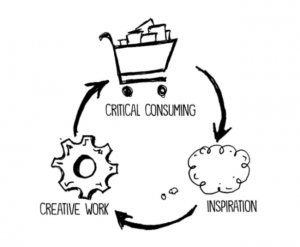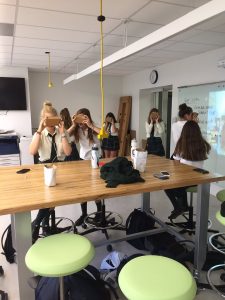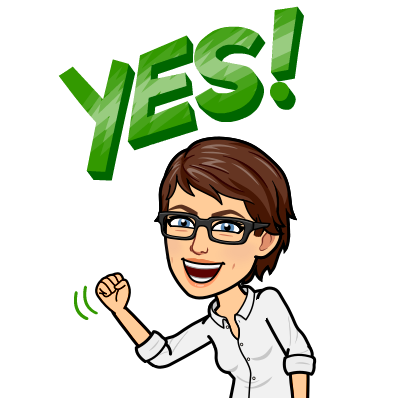The phrase ‘the end of the beginning’ resonates as I sit down to gather my ‘placemats’, notes, piles of reading, and thoughts on this incredible Cohort experience. It is hard to know where to begin because of this nagging feeling …”but I’m not DONE yet !!!!!” I understand of course, that I will never be done. In an article that @gnichols shared with me, George Couros, in discussing the shift in education from product to process laments (paraphrased) “when the pace of change is so fast, the only way to retain a lifelong working capacity is to engage in lifelong learning. ” I am still in that ‘Spaghetti Junction’ that I spoke about in my first post back in the fall… I have pursued a few ‘noodles’, but ultimately, exploring my original idea led to new ideas, and the conversations with Cohort members and strategy leaders at our school led me in new directions.
For me, this has been a year of process work. I do not have a final product, and because there has been no pressure to do so, I was able to think more deeply about where I will go with what I have learned.
The Cohort approach to personalized learning through deep design process work and connection with others has also highlighted for me the type of learner I am; I am not comfortable jumping into action without an enormous amount of knowledge and understanding behind me. In a quick skim of ‘Empower‘ by AJ Juliani and John Spencer (2017) I strongly identified with their visual of the necessity of critical consumption that leads to inspiration and creative/innovative work.

Thus, developing a culture of empathy became a deeper dive than I anticipated at the outset. This realization started from the beginning when I set out to determine a suitable definition of empathy. In the social sciences (my background discipline), it is often referred to as ‘compassionate empathy’, which moves a person to respond to another’s emotional state with some kind of action, as compared with ‘cognitive empathy’, also known as perspective taking, which is simply understanding another person’s mental state.” (Ugolik, 2017)
PHASE 1:
For my initial question, ‘How might we integrate empathy into the curriculum to encourage action? ‘ I incorporated the former definition as it was the most relevant to what I was trying to accomplish. Our school strategy incorporates innovation as a key component and as I am trying to become more proficient with the use of technology in the classroom, I decided to investigate the use of Virtual Reality (VR) in integrating empathy into the curriculum.

At the outset, I had a couple of ideas for what I hoped would be positive outcomes. As a parent and a teacher, I had been reading about the concerns around youth and excessive use of technology correlating with the decline in social connections. I felt that perhaps we could take these same tools that are responsible for students looking inward, and flip the outcome to use them so that students might look more outward. Part of the core of the IB diploma program, CAS (Creativity, Action, Service) is woven into the curriculum. I took this opportunity to pose the following question: How can VR build empathy and encourage action?
After showing the documentary, many of the girls quickly identified their prior perceptions of refugees as stereotypes; many of the people living in Za’atari fled white collar jobs, middle/upper class homes and their country, Syria was once stable and considered to be a middle income country. My students were mesmerized by the power of the VR experience to draw them into the scene – the middle of the world’s largest refugee camp, Za’atari in Jordan. The film tours the camp through the eyes of a 12 year old girl. One student commented:
“At times it’s as if people are pointing at you, talking to you, looking at you straight in the eye – expecting you to engage, to say or do something … but you can’t. ”
Chris Milk, an American entrepreneur, innovator and presenter of the widely viewed TED Talk where he characterizes the use of VR as an ’empathy machine’ describes the power of using VR this way: “What we care about are the people who are local to us, and virtual reality can take anyone in any place and make them feel local to you.” (Milk, 2015)
In terms of outcomes, the experience was able to build ‘cognitive empathy’ rather than ‘compassionate empathy’ as I had hoped. The students saw many of the quiet aspects of their day to day lives reflected in the youth of the film. The children go to school, have aspirations to join a profession, worry about fitting in, struggle to understand the opposite gender, play sports & prioritize a family meal at the end of the day. They were surprised to see that community could exist in such dire circumstances. They were able to make the connection that really, anyone could become a refugee, that the designation is indiscriminate. Through seeing the commonalities in their shared experiences with the youth in the film they were able to empathize – to an extent, with the youth. In this way, I felt I had had some success. After reading @gnichols response to my blog post where he articulated the evolution of ‘technology-integration’ to ‘innovative teaching and learning’ I recognized why. The notion that innovative teaching and learning should keep the focus on the type of learning you want to happen (in this case I wanted my students to identify with the students in the video) and apply the relevant technology later rather than focussing on the tool you want to use. “Learning should always lead the conversation.”

The piece that did not emerge, as I had anticipated, was the opportunity to develop a CAS project (action) as a result of seeing the film. Though we discussed opportunities for action within our local community, the bit that is missing for me as an educator is ‘what comes after the VR experience’? Unicef and other organizations have had positive results from the use of VR for fundraising, but they comment that it can be improved as a tool for action as the technology improves and incorporates artificial intelligence in order to leverage collaboration among diverse stakeholders. One Unicef representative puts it this way: “Then we can design activities that are really out there to ask people to use their brains and use their hands and their capacity to help us solve certain problems. That’s a very different thing than just saying, ‘Hey, give money, this thing is really sad.'” (Watercutter, 2016)
Using VR as an ’empathy machine’ has its detractors too. For one, empathy is inherently biased; we must imagine that if empathy is employed through VR as a tool for pursuasion, then the emotion could be exploited for all sides of an argument. In addition, if VR films are made to appeal to certain audiences by others like the audience members then the experiences run the risk of using a new medium to reinforce old forms of bigotry. Ethan Shaftel, creator of the Tribeca VR film Extravaganza believes that “VR is an immersion machine. It can and does transport you. But in many ways, you bring your ‘you-ness’ with you.” (Robertson, 2017)
Again, this idea put forth by ‘The Innovators Mindset‘ author George Couros, that content knowledge is crucial in a time of innovation. I would add that in addition to knowledge and context, training in SEL (social emotional learning) competencies would add value in achieving ‘compassionate empathy’.
PHASE 2:
After a productive Google hangout with @Ddoucet and @lmustard, I started to realize that I didn’t want to limit my investigation of empathy only to how we might leverage tech to integrate empathy into the curriculum. The design thinking process was something investigated as a professional goal last year and wanted to learn more about this year. My action plan morphed a little here to encompass curriculum design structures / teaching strategies as a way of integrating empathy into the curriculum.
There are two assessments I am creating / revising this year which incorporate the design thinking process into a summative design challenge. My Geography Diploma 1 (Grade 11) teaching partner and I are thrilled to be partnering with Maximum City not-for-profit working with schools, governments and communities to learn and live in better cities. Our design challenge will involve students working in design teams to create their vision of a sustainable urban future for Toronto in 2050. The challenge question for students will be – what information do you need to know about city dwellers in 2050? What will their needs be? This will require the application of foresight to empathy, which is another whole area of interest to me. This process will begin with an empathy mapping exercise on May 9th of this year.
Last year, I created a design challenge (in partnership with Maximum City) for my Grade 10 Geography students around the question: How might we design a more accessible transit system in Toronto? What I learned from the experience was that I hadn’t tested my assumptions quite thoroughly enough! I assumed that all students would be familiar with the TTC as regular riders. I recognized immediately that this was not the case. As such, I am adjusting the beginning phase of the project to include a more structured empathy mapping exercise following a ‘day out on the TTC’. I hope to have students identify areas of need around the city and then go and ‘ride the rocket’ in these areas so that they might more critically empathize with issues of accessibility facing TTC riders.

PHASE 3:
Next, I took part in a few conversations involving our school strategy in the areas of well-being, international mindedness and innovation. I started to notice that empathy seemed to be a key point of intersection. At this point, my interest crossed the zone of being something that was relevant in the classroom context to something more relevant to whole school culture. These conversations have been even more interesting for me because in exploring the Strategic Plan links I had the chance to speak to our IT Director, Head of Talent Management & Strategy & the Director of our Chandaria Research Centre. I found a multiple perspective conversation on this topic to be an excellent lens through which to view the intersections of strategy with the development of a “culture of empathy”.
It seems to me that our core strategic directions of academics and research are informed by the direction we take on wellbeing, international mindedness and innovation. These priorities cannot exist in silos and, from my initial conversations with colleagues, affirms that empathy is more than a simple connector, it is the subterranean roots that hold our strategy together. It is the thread throughout these priorities that reinforces our mission: “Each day, we challenge and inspire girls to love learning and to shape a better world.”
My third pivot was directed at strategy; how might we harness the power of our strategic plan to integrate empathy into our school culture? This is the point at which I changed the wording of my action plan (visible in my slide deck) to “How might we integrate empathy into school culture to encourage action?”
Whether we approach the integration of empathy through technology, curriculum design, teaching strategies or strategic plans, it is clear to me that as The Greater Good Science Center at UC Berkeley notes “as children master their own emotions and understand the perspectives of others, they will also be able to control, develop, connect and motivate themselves more effectively.” Establishing a culture of empathy then, is likely to achieve the nurturing and development of positive institutional relationships, without which project based learning and collaboration exercises that rely on students’ ability to empathize and care about their learning are less likely to succeed. In terms of the development of 21st century skills, the importance of fostering this ‘soft skill’ cannot be overemphasized.
WHAT’S NEXT…
- I plan to pursue involvement in strategic plan discussions in the areas of innovation and international mindedness
- In preliminary discussions with my Instructional Leader I am planning to lead a discussion within my department around how we might harness compassionate empathy and profile our curricular and co-curricular offerings as necessary complements to STEM education and the innovation agenda.
- I am going to miss the F2F sessions so much that I propose to get the ball rolling on a bi-monthy Cohort Alumni Pub night to keep the conversations going, stay tuned!
This has been the best PD that I have ever engaged in. I really want to thank all the leaders, coaches, mentors and my peers for your hard work, insight, positivity, support and most of all for creating a space to evolve my practice in a way that was unique and incredibly meaningful for me. My gratitude to you all.
“When you want to hurry something, that means you no longer care about it and want to get on to other things. I just want to get at it slowly, but carefully and thoroughly…”
-Pirsig
Works Cited
Clouds Over Sidra. Dir. Gabo Arora and Barry Pousman. VRSE, 2015. YouTube. Web. 10 September 2017.
“Educating for Empathy.” Greater Good Magazine. UC Berkeley, 18 July 2012. Web. 10 January 2018.
Ugolik, Kaitlin. “How virtual reality can make people more empathetic.” Narratively, 19 November 2017. Web. 10 Jan. 2018.
Juliani, A.J. & Spencer, John. Empower. Canterbury: IMpress, 2017. Print
Milk, Chris. “How virtual reality can create the ultimate empathy machine.” TED. 22 April 2015. Lecture.
Robertson, Adi. “VR was sold as an empathy machine – but some artists are getting sick of it.” The Verge, 03 May 2017. Web. 10 January 2018
Watercutter, Angela. “VR films work great for charity, what about changing minds?” WIRED, 03 January 2016. Web. 10 January 2018

What an amazing reflection @acampbellrogers, your journey has been wonderful. You opened yourself up to the experience and surrounded yourself with people who could push and/or challenge your ideas, both within Cohort21 and at your school.
I love your look at VR to foster empathy as well as your concerns around exploiting someone emotions. I really appreciated your research around compassionate empathy, and used it in a session @gvogt and I facilitated today with a couple of CAIS National Student Leadership crews. What is it that compels us to act? Does it always have to be a tragedy or in Graham’s words “Can’t we get ahead of this thing and be proactive?”
I LOVE your idea about Cohort Pub Nights, like #PubPD or do we just all agree to make it out to those? At any rate, I’ll make the trip once in a while to reconnect with C21 Alum.
I look forward to seeing your next steps and hope you’ll continue to blog. As your action plan shifts and takes on a momentum, I hope that you’ll continue to share your insights with us!
Dear Allison,
This thinking, rethinking, testing of assumptions and actions is an incredible look into how your practice is maturing to the point of mastery. Really, these are the thoughts and reflections of a teacher that knows that their students can be prepared for multiple futures, and is looking for different pathways to support their journey forward.
This post really resonates with me and the work that I am trying to do in our school through the Forum for Change and our excellent staff there. I’d love to connect you with them, if you would be willing. I think you would come to some really generative action.
let me know,
garth.
@gnichols, I would love to meet with your colleagues in the Forum for Change; let’s connect around that. The whole Cohort experience has really pushed my thinking this year, and contributed to a shift in mindset and approach … AJ Juliani captures it best: “Out job is not to prepare students for something. Our job is to help students prepare themselves for anything.”